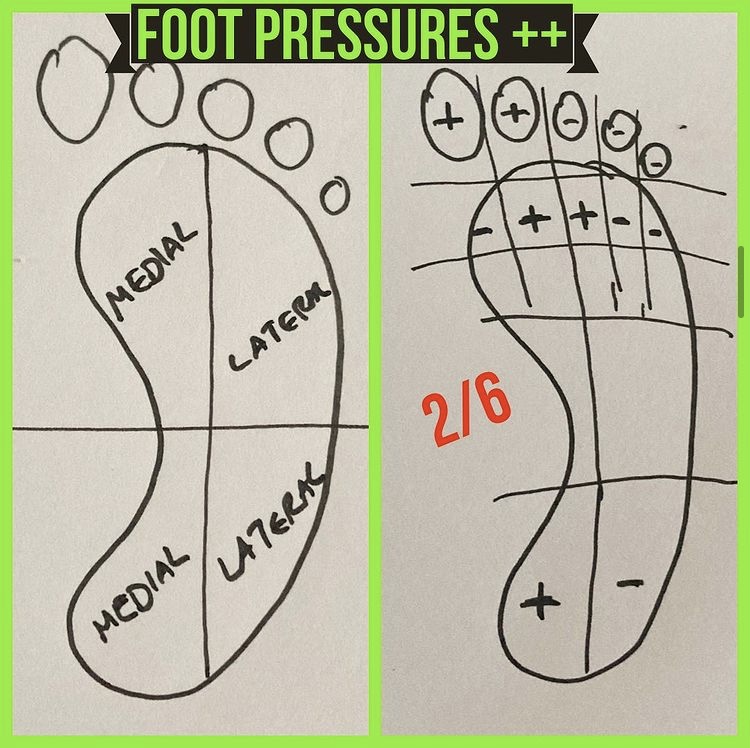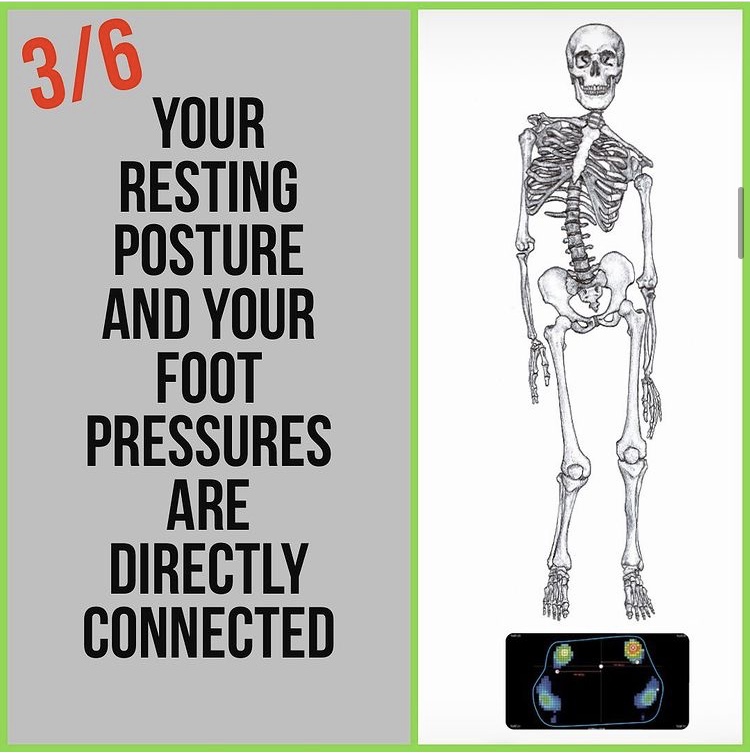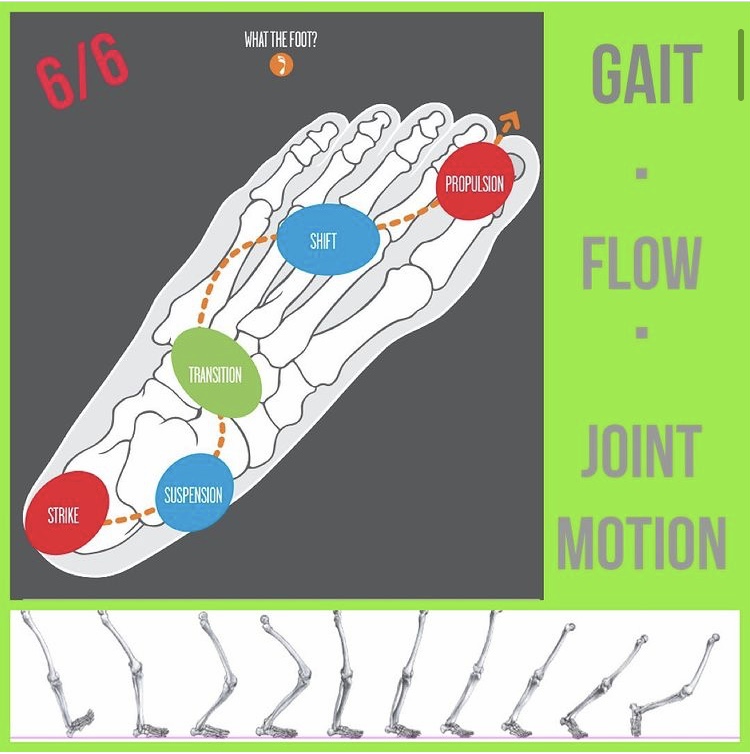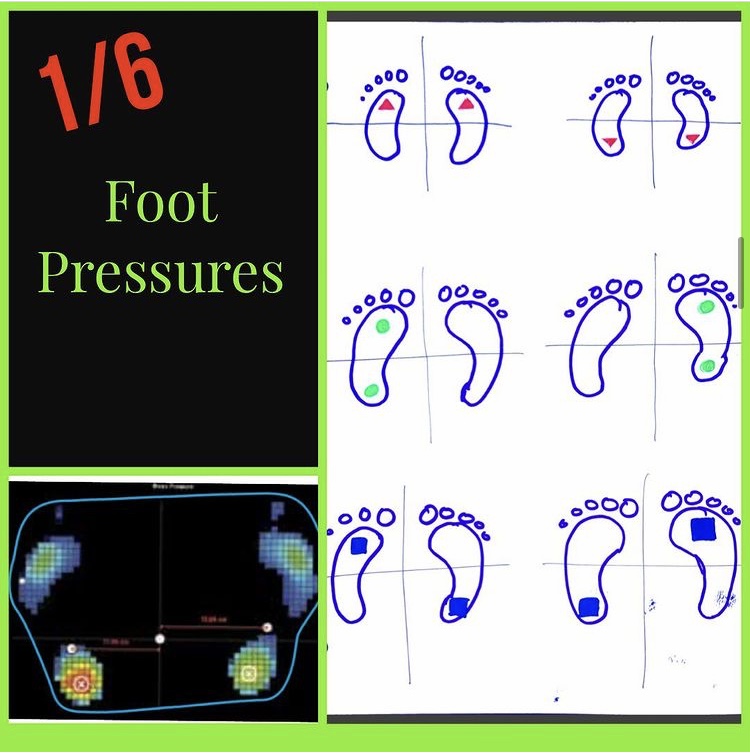👣 Both of my programmes, WAKE YOUR BODY UP and WAKE YOUR FEET UP start in a very interesting place. With what we call your foot pressures. This is the area of your feet that is in contact with the ground when you are stood. It’s really important to bring awareness to this aspect of human movement as not only does it tell us a lot about your foot shape, but also a huge amount about your whole body response and your movement potential. I am confident to say that given your foot pressures only, 8 times out of 10 we would be able to guess your posture and likewise given your posture, we could second guess your foot pressures.
👣 Dividing your foot up into four equal parts (as does a force pressure platform) you might find that you rest in your feet in any multiple of six different ways as per the image. Pressure in both forefeet, pressure in both heels, pressure predominantly in your left foot or right foot and pressure in left heel and right forefoot or right heel and left forefoot. What are you doing? Let us know in the comments below.
👣 If, for instance you have pressure in your left heel and right forefoot, we know that 8/10 you will have a pelvis rotated to the left, pressure in both heels often associated with a lumbar lordosis, and of course majority weight left means too much of your anatomy is left of where it should be… Can you see how a bent knee might push the pressure forwards and a dropped shoulder might put pressure into the same side foot. You can tell a lot from your foot pressures and by affecting movement in your whole body, a just reward is to observe over time the pressures adjusting back toward a more normal balanced distribution of pressure. 25% in each quadrant, 50%-50% left to right and a variant of 50%-50% to 60%-40% in favour of heels front to back.

👣 A further split from the four quadrants is also to split the forefoot and rear foot into left and right (in each individual foot) as well.
This means you might become aware that the pressure sits mainly in your heel, but with greater focus that it’s actually on the inside of your heel rather than in the middle. Can you see how you could be predominantly bearing pressure throughout the right foot and that your left foot might have pressures on the inside of the foot while the right foot has pressures on the outside of the foot? Anything could happen to be honest, but it’s being aware of WHAT IS happening that is important, and making sense of it afterwards.
👣 Again you can separate the forefoot into left and right as well (medial or lateral) to get a sense of where predominantly your weight is (image on left). Delving even further you can split the metatarsal heads or toe knuckles into five separate weight bearing areas. You might find that actually your weight is in the forefoot, predominantly toward the inside but also sitting right there under knuckles two and three (image of right). Thus affecting your tripod and affecting your whole body movement potential.
👣 Finally be aware of your toes. Do you have excess pressure in any of your toes? In particular the big toe? You should not have resting pressure here, especially at the cost of pressure in the big toe knuckle. Instead of what’s missing? We can also think of this as what’s “excessive”… but a nice way to think of this in a fully functional 100% operating body (which we all have) is that if there is any excess anywhere, that excess is always making up for something that is missing or lacking. This is what I call the great exchange, we do it in movement, we adapt this way with our posture and even in our foot pressures.
👣 Any advance on how you hold weight in your feet now after reading this? Perhaps we can use it to start looking up at the rest of the human body.

👣 Sitting on top of your foot pressures is the posture you choose to rest in. We can complain and moan about our posture all we like, but have you ever considered that this very posture is the one you yourself have chosen over a life time of movement, habit and insult (injury). Your posture is the most efficient and energy saving posture you can muster at this point in time in your life. Trust me when I say, if you could stand in a more energy conserving way, without thought, you would. That is the nature of your innate self. This is key to making friends with your posture, creating an opportunity to work with your body as opposed to ON your body. Simply showing it a more efficient and energy conserving way to be in your body.
👣 We must do this in an unconscious fashion. I would like to show my brain what efficient movement feels like and the rewards I earn from experiencing it. If your foot pressures are all in the left foot, can you see how that simply isn’t efficient? What if you could learn to educate your body to bear more weight in the right foot? Can you see how that in theory would begin to balance you out? Where is the pressure? Where is it not? What influence might these pressures have on your resting posture?
👣 Simultaneously, with your foot pressures being more left, is your pelvis hiked on that side? Are you side bent towards it? Maybe your skull tilts that way? – some things have moved left, which likely means they cannot go right. Maybe there is a reason, perhaps for another day. Can you see how introducing a posture that you currently do not access, can change your foot pressures and allow you to be more balanced?
👣 Below we’ll see how change in a single structure will have the same if not similar response in everybody. And to recognise that postural change, establish what we need to do to restore it and diligently reintroduce lost movement to the whole body and how that can set us up for a win in our bodies.

👣 Using the example of a bent knee as a single structure, we can see how pressures in the forefoot might arise out of having one knee bent OR persistently holding weight in the forefoot night demand a bend in the knee that sits above it.
👣 A bent knee pushes your foot pressures forwards. Foot pronation also pushes your pressures forwards (and medial). Interestingly a bent knee just so happens to couple with a pronating foot (I’m not talking about a knee bent and intentionally directed out towards little toes, here, but an unconscious relaxed knee bend). All of this together likely creates a pelvis that rotates away from the bent knee and a counter rotation in the spine. If you rotate your pelvis left, you should feel pressure enter your right forefoot! So much information can arise from a single structure. Just take a moment to think about how many muscles have changed their resting state as a result of this.
👣 Put fifty bent knees in a room and over 40 of them are likely to experience the same response in the rest of their body. This is because it’s the most efficient response a body can have to a single bent knee. Anything else would be even less efficient and even begin to contribute to pain and discomfort where these rules are broken. How you rest in your posture over your foot pressures can tell us a lot about what we have to work with in the body. Having felt your foot pressures, it’s important to check how you are standing as your resting posture stance does contribute to those pressures… it’s also useful to recognise that influencing the feet to hold pressure where they normally do not, can reach upwards and influence the body above as well. What if we could work with both together for maximum effect?
👣 What postural anomalies do you have do you think and if you alter them, do you feel a subtle change in your foot pressures?

👣 Your resting posture, believe it or not, determines your capacity for movement. Or looked at another way. Your movement limitations directly contribute to your posture. A potential chicken and proverbial egg scenario. See my series ‘movement lives on a spectrum’ to get up to date. In the big picture, there are not that many movements that you should be able to do. There are only two foot and leg movements and the vast majority struggle ENORMOUSLY with both (Wake Your Feet Up 😉).
👣 Eight pelvis movements. Six ribcage and skull movements. Six shoulder movements and a shoulder girdle capable of responding to the engagement of movement between the arm and the ribcage. Three dimensions of movement in each – forwards and backwards; side to side and in rotation. All with different anatomical names but in essence nothing more complex than that. Each are spelled out for you in my Wake Your Body Up programme. Your goal as someone who has discovered that their foot pressures are not as they could be and noticed a correlation with their resting posture should be to:
a) document your pressures, a drawing will do
b) document what you make of your posture, a drawing will help
c) now check every single movement (not many) in your body following the strict rules I outline in the programmes. The sheer act of doing so is to begin to unconsciously tap into movements you otherwise would not.
👣 Imagine your brain has a choice: A:
this sparkly new movement I was not aware was possible to do or B: that shitty old movement that I have unconsciously used for years (thinking it was my previous best bet and most efficient!) but has proven problematic for me…. Which would you choose? Actually I put more faith in the brain’s unconscious choice than most human’s ‘thought about too much’ choice (no offence!! 😆)
👣 Explore new movement, experience new movement and below I’ll talk about sequencing these movements together to simply make sense for the body and generate a previously unexplored and untouchable flow. Overcoming your restrictions in the body will give you access to such a state in your own time and capacity.

👣 I think of flow as something having it’s natural unobstructed energy and permissions to move, almost as designed. Our bony surfaces determine the movements capable at our joints – same in each of us in terms of the permissions they allow us for movement. It is truly magical to behold. We ground them out ourselves over millennia to walk and move the way we move today.
👣 I chose to map the human walking gait cycle, a journey of every single bone and joint in the human body through a single footstep and ultimately stride. There is 100% a way of walking that is the most efficient way of us doing so, with energy conserved, zero compensations, literally everything operating as it ‘should’ in it’s effortless state – any other way by comparison is unfortunately a step away from the body’s natural flow and rhythm, less efficient, more costly of energy and more effortful.
👣 Would you be surprised if I told you that to access this flow you must be able to freely access all of the movements described in the previous post. Equal movement in both directions in all three dimensions: forwards and backwards 🕺🏻 side to side 🕺🏻rotations left and right. In all of your joints, from your feet and ankles, thru the knee, hips and pelvis, spine, ribcage, skull, shoulder girdle and arms. Can it really be so hard? The Flow Motion Model helped me to realise that there are natural sequences in the body. A relationship between the foot and the leg to the pelvis, a connectivity from pelvis to spine. A relationship between the arms and the ribcage which is connected via the pelvis to the legs and those foot pressures we began with. So not only can you do those movements, but once you have access to them anew, are you able to to sync them up as determined by the model?
👣 Again this is shown in the Wake Up series of videos and available for online learning in the Closed Chain Lower Limb courses. I wish I could teach in person right now, unfortunately I can’t so we are online for now and grateful that so many people are able to benefit and learn right now.

👣 What’s missing really is KEY.
👣 What’s missing can be expanded to what areas of the foot do not have pressure? Pressure is missing there. What aspects of resting posture do you not occupy? And what movements are you unable to access of all the movements available?
👣 Remember that knee bent pattern: weight in the forefoot, pelvis rotated away? What about introducing that to the opposite side, as it will be hindered by the presence of that bent knee. What about introducing the opposite to the bent knee: Straightening the knee, inviting foot pressures into the heel and a pelvis that can now rotate towards the leg. Just by playing with this, you are tapping into two key phases of the Flow Motion Model. What permissions do these new movements create for the rest of the body to reorganise itself. The new movements, the flowing experience of sequenced together joint motions, the access to areas previously abandoned and forgotten about, pathways covered by an overgrown forest that just need to be re-membered, trimmed back and exposed to life again.
👣 All of these patterns are utilised in our online programmes. All of these patterns are and will continue to be educated in our online courses. I am keen to stress that working on muscles alone, even focussing on the nervous system as a way of granting access to the brain’s experience of itself is limited in comparison to having the joints explore their fullest potential through movement, not just local movement but global flowing movement through the phases of the walking cycle that we worked so so hard over millennia to forge for ourselves to have efficient access and freedom to roam this planet.
👣 What’s missing? Could be a key player in this conundrum for you.
Continue Your Journey
👣 Download the Free 7-steps to take ownership of your body. Access the free ebook here
👣 Get started with our self-assessment programmes for Everyone.
👣 As a professional bodyworker, our online Educational courses are for you.


Leave A Comment